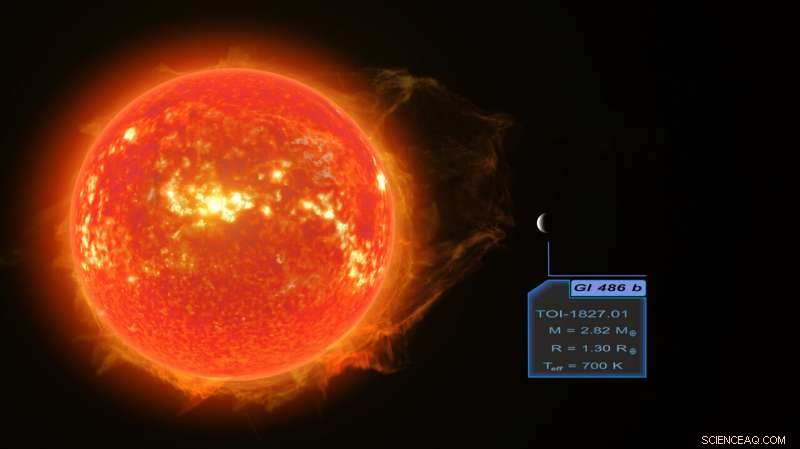
Momenti del viaggio virtuale, con dati astronomici sovrapposti. Credito:RenderArea
Negli ultimi 25 anni gli astronomi hanno scoperto un'ampia varietà di esopianeti, fatto di roccia, ghiaccio e gas, grazie alla costruzione di strumenti astronomici progettati appositamente per le ricerche planetarie. Anche, utilizzando una combinazione di diverse tecniche di osservazione sono stati in grado di determinare un gran numero di masse, dimensioni, e quindi densità dei pianeti, che li aiuta a stimare la loro composizione interna e aumenta il numero di pianeti che sono stati scoperti al di fuori del Sistema Solare.
Però, studiare le atmosfere dei pianeti rocciosi, che avrebbe permesso di caratterizzare pienamente quegli esopianeti simili alla Terra, è estremamente difficile con gli strumenti attualmente disponibili. Per tale motivo, i modelli atmosferici per i pianeti rocciosi rimangono non testati.
Quindi è interessante che gli astronomi nel CARMENES (Calar Alto high- Resolution search for M nane with Exoearths with Near-infrared e Optical échelle Spectrographs), consorzio di cui l'Instituto de Astrofisica de Canarias (IAC) è partner, hanno recentemente pubblicato uno studio, guidato da Trifon Trifonov, astronomo al Max Planck Institute for Astronomy di Heidelberg (Germania), sulla scoperta di una super-Terra calda in orbita attorno a una vicina stella nana rossa Gliese 486, solo 26 anni luce dal Sole.
Per fare ciò gli scienziati hanno utilizzato le tecniche combinate di fotometria di transito e spettroscopia di velocità radiale, e usato, tra gli altri, osservazioni con lo strumento MuSCAT2 (Multicolor Simultaneous Camera for study Atmospheres of Transiting esopianeti) sul telescopio Carlos Sánchez di 1,52 m presso l'Osservatorio del Teide. I risultati di questo studio sono stati pubblicati sulla rivista Scienza .
Il pianeta che hanno scoperto, chiamato Gliese 486b, ha una massa 2,8 volte quella della Terra, ed è solo il 30% più grande. "Calcolando la sua densità media dalle misurazioni della sua massa e raggio deduciamo che la sua composizione è simile a quella di Venere o della Terra, che hanno al loro interno nuclei metallici, " spiega Enric Pallé, un ricercatore IAC e coautore dell'articolo.
Gliese 486b orbita attorno alla sua stella ospite su un percorso circolare ogni 1,5 giorni, a una distanza di 2,5 milioni di chilometri. Nonostante sia così vicino alla sua stella, il pianeta ha probabilmente conservato parte della sua atmosfera originale (la stella è molto più fredda del nostro Sole) quindi è un buon candidato per osservare più in dettaglio con la prossima generazione di telescopi spaziali e terrestri.
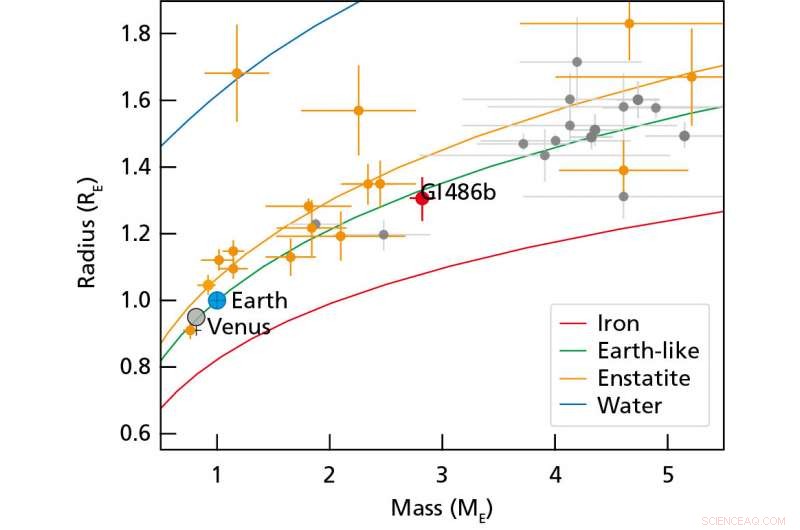
Il diagramma fornisce una stima delle composizioni interne di esopianeti selezionati in base alle loro masse e raggi in unità terrestri. Il punto rosso rappresenta Gliese 486b, ei simboli arancioni rappresentano i pianeti intorno a stelle fredde come Gliese 486. I punti grigi mostrano i pianeti ospitati da stelle più calde. Le curve di colore indicano le relazioni teoriche del raggio di massa per l'acqua pura a 700 K (blu), per il minerale enstatite (arancione), per la Terra (verde), e ferro puro (rosso). A confronto, il diagramma evidenzia anche Venere e la Terra. Credito:Trifonov et al./ Dipartimento di grafica MPIA.
Per Trifonov, "Il fatto che questo pianeta sia così vicino al sole è entusiasmante perché sarà possibile studiarlo più in dettaglio utilizzando potenti telescopi come l'imminente James Webb Space Telescope e l'ELT (Extremely Large Telescope) in costruzione".
Gliese 486b impiega lo stesso tempo per ruotare sul suo asse come per orbitare attorno alla sua stella ospite, so that it always has the same side facing the star. Although Gliese 486 is much fainter and cooler than the Sun, the radiation is so intense that the surface of the planet heats up to at least 700K (some 430 degrees C). A causa di ciò, the suface of Gliese 486b is probably more like the surface of Venus that that of the Earth, with a hot dry landscape, with burning rivers of lava. Però, unlike Venus, Gliese 486b may have a thin atmosphere.
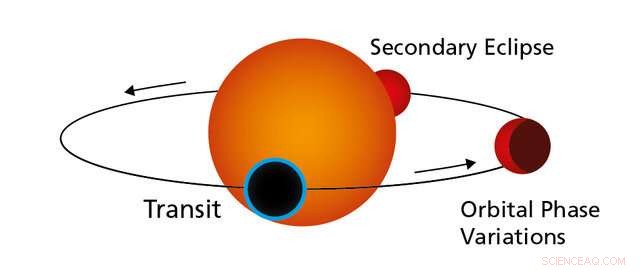
The graph illustrates the orbit of a transiting rocky exoplanet like Gliese 486b around its host star. During the transit, the planet eclipses the stellar disk. Contemporaneamente, a small portion of the starlight passes through the planet's atmosphere. As Gliese 486b continues to orbit, parts of the illuminated hemisphere become visible as phases until the planet disappears behind the star. Credit:MPIA Graphics Department.
Calculations made with existing models of planetary atmospheres can be consistent with both hot surface and thin atmosphere scenarios because stellar irradiation tends to evaporate the atmosphere, while the planet's gravity tends to hold it back. Determining the balance between the two contributions is difficult today.
"The discovery of Gliese 486b has been a stroke of luck. If it had been around a hundred degrees hotter all its surface would be lava, and its atmosphere would be vaporized rock, " explains José Antonio Caballero, a researcher at the Astrobiology Centre (CAB, CSIC-INTA) and co-author of the article. "D'altra parte, if Gliese 486b had been around a hundred degrees cooler, it would not have been suitable for the follow-up observations."
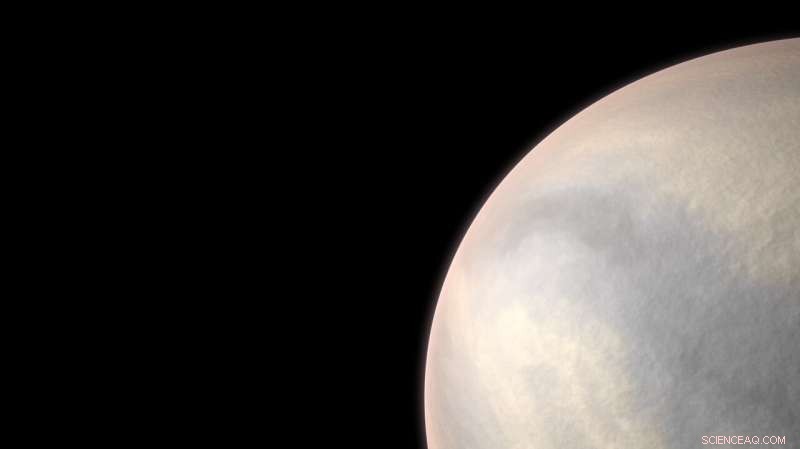
Artist's impression of the atmosphere of Gliese 486b. Credit:RenderArea
Future planned observations by the CARMENES team will try to determine its orbital inclination, which makes it possible for Gliese 486b to cross the line of sight between us and the surface of the star, oculting some of its light, and producing what are known as transits.
They will also make spectroscopic measurements, using emission spectroscopy, when the areas of the hemisphere lit up by the star are visible as phases of the planet (analagous to the phases of our Moon), during the orbits of Gliese 486b, before it disappears behind the star. The spectrum observed will contain information about the conditions on the illuminated hot surface of the planet.
"We can't wait until the new telescopes are available, " admits Trifonov. "The results we may obtain with them will help us to get a better understanding of the atmospheres of rocky planets, their extensión, their very high density, their composition, and their influence in distributing energy around the planets.
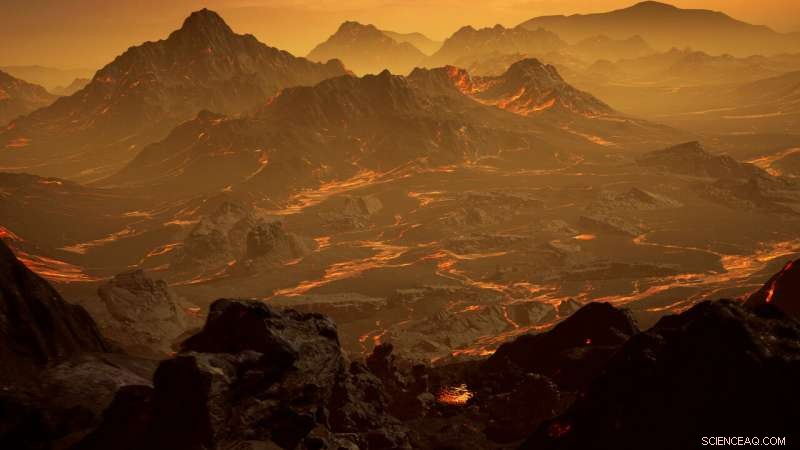
Artistic impression of the surface of the newly discovered hot super-Earth Gliese 486b. With a temperature of about 700 Kelvin (430 °C), Gliese 486b possibly has an atmosphere. Credit:RenderArea

Colorized 2D spectra of the star Gliese 486 as seen with MAROON-X. The two spectra are from the two camera arms of MAROON-X. Each spectrum covers the 500-670 nm wavelength range and the color-coding corresponds to how a human eye would perceive the colors. Credit:International Gemini Observatory/NOIRLab/NSF/AURA/A. Seifahrt
The CARMENES project, whose consortium is made up by 11 research institutions in Spain and Germany, has the aim of monitoring a set of 350 red dwarf stars to seek planets like the Earth, using a spectrograph on the 3.5 m telescope at the Calar Alto Observatory (Spain). The present study has also used spectroscopic measurements to infer the mass of Gliese 486b. Observations were made with the MAROON-X instrument on Gemini North (8.1m) in the USA, and archive data were taken from the Keck 10 m telescope (USA) and the 3.6m telescope of ESO, (Chile).
The photometric observations come from NASA's TESS (Transiting Exoplanet Survey Satellite) space observatory, (USA), whose data were basic for obtaining the radius of the planet, from the MuSCAT2 instrument on the 1.52m Carlos Sánchez Telescope at the Teide Observatory (Spain) and from the LCOGT (Las Cumbres Observational Global Telescope) in Chile, among others.